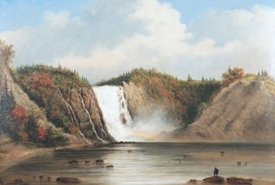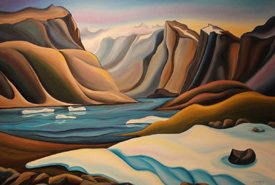Conservation's a work of art

Montmorency Falls, 1853, Cornelius Krieghoff (1815-1872) (Photo from Wiki Commons)
Art is all about interpretation. That’s what I love about it. Two people could look at the same painting and see completely different things. As both an artist and nature lover, I have always been drawn to impressionist representations of the environment in art.
Throughout history, nature and the environment have been prominent influences on Canadian art specifically. Whether in landscape work like that of the Group of Seven or in more contemporary political pieces about climate change and habitat vicissitudes, art is telling the story of nature.
Canadian painter Cornelius Krieghoff’s (1815 – 1872) work focused primarily on the great Canadian outdoors. He would often paint pieces depicting the Canadian landscape and culture with scenes such as The Habitant Farm (1856) and The Ice Bridge at Longue-Pointe (1848). It is in his work, Montmorency Falls (1853), Krieghoff depicts a scenic view of the Falls as it looked in the 1850s. If you travel to Quebec City, you can still visit the falls and see how they have changed since Krieghoff painted them more than 160 years ago.
Contemporary artists are also using traditional media to capture changes in the environment.
“A picture is worth a thousand words,” says artist Linda Lang. “People won't necessarily read pages of scientific journals, but it is my hope that a painting can illustrate these changes [in the environment] and that people will feel an emotional response.”
Lang is a painter, specialising in expedition and climate change art. On one of her several expeditions to the Arctic, Linda recognized the fast and devastating alterations in the environment.

View From Glacier, Pangnitung, 2004, Linda Lang (Image courtesy of the artist).
It was a chilly day in Pangnirtung. Her palette was filled with picturesque Arctic colours: snowy whites and glacier blues. Sitting down to paint her landscape, Lang could hardly wait to recreate the snowy tops of her favourite mountains on Baffin Island — until she looked up.
“When our ship pulled into the fjord, my heart dropped,” said Lang. “The ice caps had almost completely melted, and the browns and greys had been replaced with greens. It had happened so fast, I didn't even bring the right yellow with me to mix the greens that were now appearing.”
Lang had checked with local Inuit artists, who confirmed the snow and ice that had been there for a hundred years previously had completely melted in the last five.
Even international artists are using Canada’s vast and diverse environment as inspiration for their work. One sculptor, Simon Starling, uses invasive species as inspiration, turning the species into a work of art.
Starling was born in 1967 in Epsom, England. His work focuses on various ecologies (environmental, political, and cultural) and how they are constantly moving and evolving. In a piece Infestation Piece (Musselled Moore), Starling took inspiration from Toronto sculptor’s Henry Moore piece, Warrior with Shield, and covered his version in real-life zebra mussels. He achieved this by submerging the sculpture into Lake Ontario for 18 months, where the invasive and rapidly reproducing zebra mussels attached themselves.
Art is a quintessential and influential way to portray changes in the environment. By integrating nature and the environment into art, the artist open’s the eyes of people who may be more obliged to visit an art gallery than reading a scientific report. Art is helping to increase the demographic, further spreading the story of our planet and the call for conservation.


